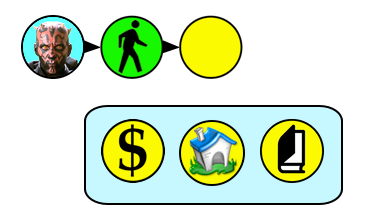SympolTalk is an iconic language system based on my previous efforts at interface languages for interactive storytelling. It is a logographic language using large (64-pixel) glyphs rendered in 24-bit color. Sentences in SympolTalk are displayed in a two-dimensional structure.
Dictionary
I have not yet compiled a dictionary of SympolTalk that is specific to Siboot. This figure presents my current random pile of word-icons and shows the overall structure underlying those words:
Imprecision
SympolTalk is not intended to offer precision in expression; vagueness is a design desideratum. This unconventional feature is derived from an appreciation of the facility of the human mind for imposing narrative structure onto sequences of events. Just as we impose imagery onto Rorschach blots, or recognize clouds to be shaped as ships or birds, our minds automatically assemble any sequence of events into a story. Experiments with children have demonstrated that they will describe a purely physical sequence of events in narrative terms, imbuing inanimate objects with purpose and personality.
Artists have long known that what is unspoken or undisplayed can be just as important as what is spoken or displayed. The shadow is just as important to the image as the light. The imagination can readily fill in what is not available, and ofttimes what is imagined is more vivid than what is real.
SympolTalk is designed with these concepts in mind. Instead of having a plenitude of words for punch, slap, hit, kick, bash, clout, brain, clobber, and so on, we need have only two words: one word for "apply power/violence to" and a second word indicating the medium of such application: fist, gun, knife, etc.
Core visual concepts
In SympolTalk, there are only six classes of words: verbs, characters, stages, props, personal traits, and modifiers. Each class has its own distinctive color: green for verbs, light blue for characters, yellow for stages, magenta for props, purple for personal traits, and brown for modifiers. Note how the standard linguistic class ‘noun’ has been broken into three components: characters, stages, and props. These are the only forms of nouns needed for SympolTalk. Conversely, adverbs and adjectives have been merged into a single category called ‘modifiers’, although personal traits form a separate class.
A Sympoltalk glyph consists of an image representing the concept embedded in a circle whose background color denotes the class of word. Thus, a tombstone in a yellow circle refers to a grave; the same tombstone in a green circle indicates killing or dying; the same tombstone in a brown circle would mean “fatal” or “mortally”.
Several other basic images extend the utility of each glyph. A brown circle containing the standard negation symbol (circle with diagonal bar) is a modifier that means “nothing” or “zero” or “not”; a pair of curled arrows connected head-to-tail indicates “reversal”. Thus, a modifier glyph meaning “beautiful” can be reversed in meaning to “ugly” by attaching the “reversal” glyph to it. Magnitude of modifiers can be shown with a simple five-step iconic scale.
Fundamental to SympolTalk is the division of emotional relationships into three dimensions: affection, power, and trust. Just as the division of the color spectrum into discrete colors is an arbitrary cultural artifact, the division of the spectrum of human relationships into discrete terms is also arbitrary. I have learned, through much trial and error, that in computational terms the three dimensions I mention above do a pretty good job of covering human relationships.
Those three relationship concepts are expressed in SympolTalk with something like the radicals used in some writing systems. A heart indicates affection, a spiky explosion indicates power, and a square indicates trust. Thus, a glyph containing a face with a speech bubble indicates a speech act; that speech act can be either nice (with a heart), domineering (with an explosion) or sincere (with a square).
Similarly, a speech act can contain an exclamation point to indicate imperative mood, a question mark to indicate interrogative mood, or a period to indicate declarative mood.
The grammar of SympolTalk is so simple as to be primitive. There are no variations in words; no tense, mood, case, number, or gender. The only grammatical indicator is a small arrow connecting one glyph to another. That arrow indicates either the sentence order (SVO) or the modulation of one word by another.
Tooltips will be available to provide a quick approximate translation of a glyph in natural language. A dictionary can always be provided to the uncertain user.
Inverse Parser
Even more radical is the use of an inverse parser. In conventional languages, the speaker must memorize all the words in the language, their meanings and usages. In SympolTalk, the user never has the opportunity to put words together arbitrarily. Every verb requires a considerable amount of computer code that specifies exactly how that verb functions in the linguistic universe of SympolTalk. This code also specifies the responses available to the user. Thus, a user constructs a sentence glyph by glyph. At each juncture, the software determines which words could meaningfully be used at that point in the sentence, and the acceptable words are presented to the user as a menu. The next figure shows an incomplete sentence as a user would see it:

The user has just selected the verb “go to”; the inverse parser knows that this verb can take only a stage as its object, and so presents the user with a floating menu of the three stages that Darth Maul could go to: the bank, the home (of an as-yet unspecified character), or the library. The user clicks on a word to make their choice. It is also possible to undo selections.
That should cover the basics.
